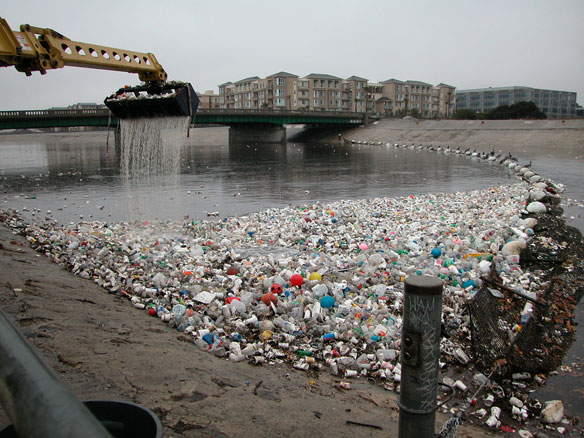Production of plastic has increased from 0.5 million tonnes in 1950 to 260 million tonnes in 2007. It is versatile, lightweight, flexible, moisture resistant and relatively inexpensive. Their attractive qualities lead us, around the world, to an over-consumption of plastic products. However, conventional plastics, which make up 60-80 percent of marine litter from the poles to the equator, are durable and very slow to degrade. They are harmful to marine animals as they release toxic additives including flame retardants, antimicrobials and plasticizers into the marine environment during degradation. Use of a biodegradable polymer that degrades more quickly than conventional plastics may present a solution to the problem.

Mouth of the Los Angeles River, Long Beach, California. (Photo source: ©© Bill McDonald, Algalita Foundation / Heal The Bay)
During April 2008 – March 2009, researchers from Marine Biology and Ecology Research Centre of University of Plymouth investigated breakdown of four types of plastics in the marine environment, including two different oxo-biodegradable formulations trademarked as TDPATM, a biodegradable bag manufactured using GM-free corn starch, vegetable oils and compostable polyesters, and a standard polyethylene bag produced from 33% recycled materials.
The scientists fastened 20 wooden sample holders to a beam attached to a floating pontoon at Queens Anne Battery Marina, Coxside Plymouth, Devon and examined degradation at 4, 8, 16, 24, and 40 weeks. After 24 weeks of exposure, the compostable polyester samples lost 100% of their surface area. However, the other materials lost only approximately 2% of their surface area over 40 weeks exposure. Fouling by marine organisms reduced the sunlight reaching the surfaces of the standard polyethylene, TDPATM 1 and 2 samples, which resulted in much slower degradation.
Plastics in the Ocean Affecting Marine Life
Plastic bags are especially harmful to marine animals since many animals confuse the plastic litter in the ocean with food. Ingestion of plastic debris may present a threat as chemicals including phthalates, polychlorinated biphenyls and organochlorine pesticides on plastic fragments may present a toxicological hazard.

One in three leatherback sea turtles has plastic in its stomach, based on a study of over 370 autopsies. (Photo: Laura Beans)
“A large number of marine species is known to be harmed and/or killed by plastic debris… One possibility to mitigate the problem is the development and use of biodegradable and photodegradable plastics.” (Derraik, 2002)
Biodegradable polymers offer potential waste management solutions. However, there are still limitations and ethical issues about their application.
-Jennifer Liu-

One response to “Biodegradable Plastic: The New Potential Waste Management Solution”